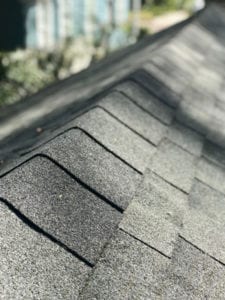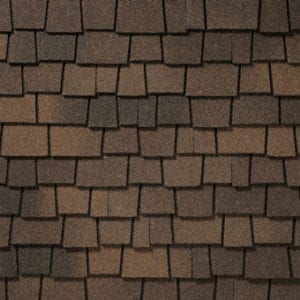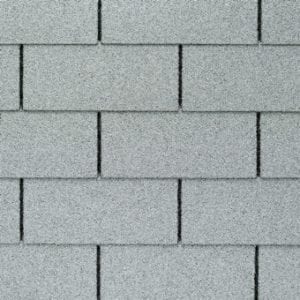 Asphalt shingles were invented in America in 1901 as a low cost and fire resistant alternative to the available roofing materials of the day. They were originally cotton rag soaked in asphalt with a variety of granules such as slate, mica, or even oyster shells added to the the surface for increased durability.
Asphalt shingles were invented in America in 1901 as a low cost and fire resistant alternative to the available roofing materials of the day. They were originally cotton rag soaked in asphalt with a variety of granules such as slate, mica, or even oyster shells added to the the surface for increased durability.
You might not give much thought to asphalt shingles since most of us don’t see our roofs up close unless there is a problem or you’re just particularly fond of heights. But you should definitely give your shingles a considerable amount of thought when it comes time to replace your roof because they are the main thing protecting your house from the weather. Even more important than keeping your house painted, the proper asphalt shingles (installed well) can make your roof last a decade longer than a poor shingle.
In this post, I’ll give you my take from experience as a general contractor of what shingles work and what are not worth your time. There are a lot of things to consider when choosing the right asphalt shingle and I’ll walk you through the things you should be paying attention to since the cost of the shingle is such a small portion of the overall cost of a new roof.
A History of Asphalt Shingles
 The first shingles were originally just single shingles unlike the wide multi-shingle sheets on the market today. Over the years, the backing material, granules, and construction of asphalt shingles has changed considerably, but the basic premise has remained the same. Their resistance to wind and hail damage has been greatly increased over the years as have the styles available to create a high quality roofing material.
The first shingles were originally just single shingles unlike the wide multi-shingle sheets on the market today. Over the years, the backing material, granules, and construction of asphalt shingles has changed considerably, but the basic premise has remained the same. Their resistance to wind and hail damage has been greatly increased over the years as have the styles available to create a high quality roofing material.
Like most building materials, the composition of asphalt shingles was largely natural materials at first before moving to more manmade versions later. In the 1920s, due to increasing costs, the original cotton backing soon became too expensive and other materials like wool, jute (see linoleum), and wood pulp were experimented with. In testing done around the time, most of these bases showed no significant performance differences so for the next couple decades there were a variety of backings used depending on the region and manufacturer.
The 1920s saw huge growth for asphalt shingles due to a campaign by the insurance companies to address the growing fire risks in America’s cities. Wood shingles, while popular and affordable created significant fire risks, whereas asphalt shingles provided fire resistance and affordability. With the advent of the great depression and asphalt shingles availability as an affordable roofing material, they only saw further growth through the post war building boom and following decades.
In the 1960s, fiberglass mats were introduced to further improve fire ratings of roofs and replace the asbestos containing shingles that found their way onto the market. While fiberglass shingles were too light to withstand high winds, originally they were eventually improved to the point where they surpassed asphalt shingles with natural backings popularity in 1982.
In the 1990s, manufacturers worked very hard to improve the wind resistance and impact resistance of asphalt shingles, especially following devastating hurricanes like Andrew in 1992. Today asphalt shingles have been improved so thoroughly that many receive the highest wind and impact ratings available for roofing materials.
What to Look For
Since the cost of a new roof is mainly labor, picking a more expensive shingle is not as financially painful as you might think. Doubling the cost of your shingles adds only a small increase to the total cost of a roof. So what should you be looking for in a quality shingle? Just like anything you do get what you pay for so even if a cheap shingle looks great, there should always be some skepticism about why it’s so cheap. Let me outline the important aspects of asphalt shingles here.
Wind Rating
You want a shingle to stand up to storms especially if you live in a high wind region like Florida or the plains which are subject to hurricanes or tornados. Yes, you can save a little here if you don’t live in a high wind zone, but is it really worth it since the chances or a strong storm coming through your area in the next 20 or 30 years is pretty good no matter where you live. Below is a list of wind ratings for roofing materials.
Asphalt Shingle Wind-Resistance Classifications
| A | 60 MPH |
| D | 90 MPH |
| F | 110 MPH |
| G | 120 MPH |
| H | 150 MPH |
Impact Resistance
A beneficial feature you may want to consider is what impact rating your shingles need. There are four levels of impact resistance, which essentially measure how well the fiberglass mat will hold up to hail and other debris. The higher the rating the stronger the shingles resistance to hail hitting your roof. That’s never a bad thing. Unlike the the wind resistance, I think that paying for the highest impact rating is not a forgone conclusion. You need to think long and hard about the kind of weather your area gets before deciding which impact level is right for your house.
Asphalt Shingle Impact-Resistance Classifications
| 1 | 1 1/4″ steel ball dropped at 12 feet |
| 2 | 1 1/2″ steel ball dropped at 15 feet |
| 3 | 1 3/4″ steel ball dropped at 17 feet |
| 4 | 2″ steel ball dropped at 20 feet |
I like having a little fun with testing products and the video below is a great example of what Class 3 and 4 shingles can stand up to. Grab a soda and check it out!
Style

The traditional 3-tab shingle has been around for years, but in the last couple decades, the rise in popularity of architectural shingles which do a good job of replicating the texture and dimensions of wood shingles has in my mind been a big improvement. Architectural shingles tend to last longer and hold up better since they are thicker and generally built with better construction. You can find scalloped shingles, shingles made to look like wood shakes, and all kinds of other custom shapes to fit the style of your house. This is especially helpful to us old home owners who need something that matches the architectural style of a historic home.
There is no right or wrong decision here, but the style is definitely something you should be thinking about since you’ll be living with it for a long time.
Color
Color is a bigger deal than you might think. Yes, it defines the look of your house and is more difficult to change than a bad paint job, but it also plays a large role in how energy efficient your house is. When I hear people rail about how important energy efficiency is and then watch them put a black shingle roof on their house I realize that all their talk of “green living” is likely just talk.

The lighter shade of shingle you choose greatly affects the heat generated by your roof. In northern states, a dark roof might well be desirable to capture as much heat from the elusive winter sun, but if you live in the south, then having black roof can increase your cooling bill significantly.
A study performed by Berkeley Labs which compared the different energy performance between black, white, and green roofs (a green roof is a roof covered in vegetation) found that “Both white and green roofs do a good job at cooling the building and cooling the air in the city, but white roofs are three times more effective at countering climate change than green roofs.”
I’m not saying you should go out and buy stark white shingles, but realizing the huge difference that shingle color can play should definitely weigh in on you decision of what shingle to buy. Think of it this way, on a sunny day, a black roof can be as much as 100 degrees warmer than the ambient air temp, while a white roof will only be about 20 degrees warmer. Think about not only your utility bills, but also the fact that a roof assembly that stays cooler has a longer life than shingles that are consistently overheated.
Warranty
There are a lot of warranties out there and while I’m not as focused on this aspect, it is often important to look into since your roof is a significant investment. Does the warranty cover materials only or does it cover materials and labor. Is it pro-rated or is it full coverage? How long does it last? How established is the company? If you have a 100-year warranty from a 2-year old company, that’s not quite as valuable as from an 80-year old company since your warranty is only as good as the company who honors it.
Picking the Best Asphalt Shingles
You should be armed with enough information to pick the right shingles at the right price for your house now. Don’t get too hung up and on the different manufacturers special options. The main issues are what we have discussed, and following these guidelines will help you compare apples to apples so you don’t accidentally end up with a lemon. Just like any home improvement purchase, take your time and put your hands on some shingles before making the final decision.
Do they feel significant or do they feel cheap and weak? Your gut is a good guide once you can get the product in your hands and see it in real life rather than on a computer screen. Use the facts above and trust your gut and you’ll be just fine. Happy roofing!
The post How To: Pick the Best Asphalt Shingles appeared first on The Craftsman Blog.
Source: https://thecraftsmanblog.com/how-to-pick-the-best-asphalt-shingles/